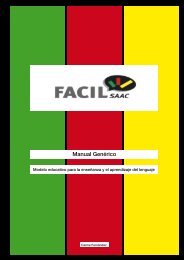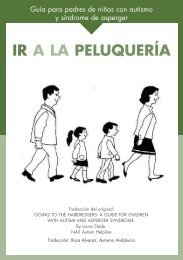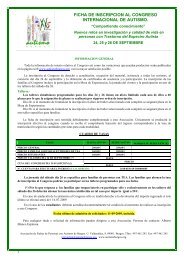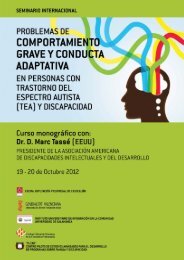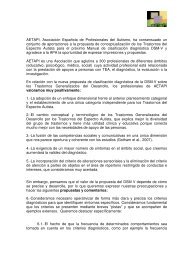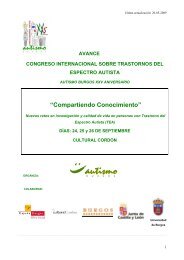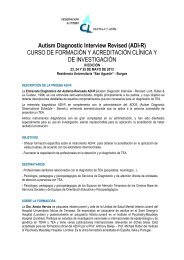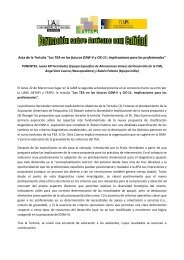persons with autism spectrum disorders - Aetapi
persons with autism spectrum disorders - Aetapi
persons with autism spectrum disorders - Aetapi
You also want an ePaper? Increase the reach of your titles
YUMPU automatically turns print PDFs into web optimized ePapers that Google loves.
4<br />
There is also individual<br />
diversity in Intellectual ability<br />
- from superior intelligence to<br />
profound retardation. However,<br />
many individuals are in the<br />
normal range.<br />
All cases present symptoms in<br />
three diagnostic areas:<br />
<br />
quite indifferent or generally<br />
passive in social interactions.<br />
Attempts by some to actively<br />
relate to others can be odd,<br />
one-sided and intrusive.<br />
Understanding of the reactions<br />
and emotions of others is<br />
limited but most can show<br />
affection in their own way.<br />
<br />
ASD also varies from individual<br />
to individual. Some never<br />
speak, some begin to speak but<br />
regress. Others speak well but<br />
have difficulties in expressing<br />
and understanding abstract<br />
concepts.<br />
Language and emotional<br />
reactions to others’ speech<br />
and body language tend to<br />
be unusual <strong>with</strong> abnormal<br />
features.<br />
In summary, social<br />
understanding is difficult for<br />
them. Persons <strong>with</strong> ASD have<br />
problems in understanding and<br />
sharing the emotions of others<br />
and also in self-expression and<br />
self-regulation of emotions.<br />
Persons <strong>with</strong> Autism Spectrum Disorders<br />
Some symptoms may be more prominent and intense at one age<br />
and may fluctuate in nature and severity at another, leading to very<br />
different clinical profiles, yet all are expressions of the same <strong>spectrum</strong>.<br />
In addition to variation in behavioural expression, there is also wide<br />
diversity in cognitive ability, which can range from average or even<br />
superior intelligence to profound retardation. Although it was previously<br />
thought that the majority of individuals <strong>with</strong> <strong>autism</strong> were<br />
severely intellectually impaired, recent research indicates that many<br />
individuals have intellectual abilities in the normal range.<br />
Despite this individual diversity, all cases present <strong>with</strong> clinical features<br />
in three domains:<br />
Disturbances in the Developmental of Reciprocal Social<br />
Interaction<br />
In some individuals there is significant social aloofness; others are<br />
passive in social interactions, <strong>with</strong> only very limited or fleeting interest<br />
in others. Some individuals may be very active in their attempts to<br />
engage in social interactions but do so in an odd, one-sided, intrusive<br />
manner, <strong>with</strong>out full consideration of others’ reactions. All have in<br />
common a limited capacity for empathy – although, again the extent<br />
of deficit is very variable- but most are able to show affection in their<br />
own terms.<br />
Impairment of Verbal and Non-Verbal Communication<br />
The development of language in ASD is extremely variable. Some<br />
individuals never acquire speech. Others begin to speak, but then,<br />
(often around the age of 18 months to 2 years) there may be a period<br />
of regression. Other individuals appear to have superficially good<br />
language but have difficulties <strong>with</strong> understanding - especially of<br />
more abstract concepts. In those who do learn to use language, both<br />
receptive and expressive difficulties are common. All individuals <strong>with</strong><br />
<strong>autism</strong> show some degree of difficulty in reciprocal, to-and-fro interactions<br />
<strong>with</strong> others. In both form and content, language tends to be<br />
unusual, and abnormal features include echolalia, pronoun reversal<br />
and making up of words. Emotional reactions to verbal and non<br />
verbal approaches by others are also impaired, and are often characterised<br />
by gaze avoidance, inability to understand facial expressions<br />
or the messages conveyed by others’ body postures or gestures.



